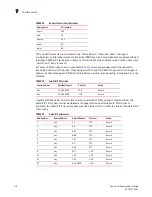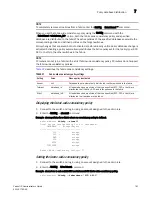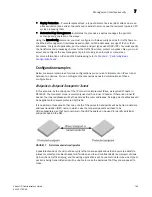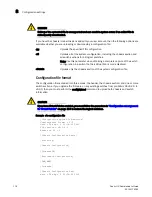
Fabric OS Administrator’s Guide
169
53-1001763-02
Management interface security
7
IKE policies
When IKE is used as the key management protocol, IKE policy defines the parameters used in IKE
negotiations needed to establish IKE SA and parameters used in negotiations to establish IPsec
SAs. These include the authentication and encryption algorithms, and the primary authentication
method, such as preshared keys, or a certificate-based method, such as RSA signatures.
Key management
The IPsec key management supports Internet Key Exchange or Manual key/SA entry. The Internet
Key Exchange (IKE) protocol handles key management automatically. SAs require keying material
for authentication and encryption. The managing of keying material that SAs require is called
key
management
.
The IKE protocol solves the most prominent problem in the setup of secure communication: the
authentication of the peers and the exchange of the symmetric keys. It then creates the security
associations and populates the SADB.
The manual key/SA entry requires the keys to be generated and managed manually. For the
selected authentication or encryption algorithms, the correct keys must be generated using a third
party utility on your LINUX system. The key length is determined by the algorithm selected.
Linux IPsec-tools 0.7 provides tools for manual key entry (MKE) and automatic keyed connections.
The LINUX setKey command can be used for manually keyed connections, which means that all
parameters needed for the setup of the connection are provided by you. Based on which protocol,
algorithm, and key used for the creation of the security associations, the switch populates the
security association database (SAD) accordingly.
Pre-shared keys
A pre-shared key has the .psk extension and is one of the available methods IKE can be configured
to use for primary authentication. You can specify the pre-shared keys used in IKE policies; add and
delete pre-shared keys (in local database) corresponding to the identity of the IKE peer or group of
peers.
The ipSecConfig command does not support manipulating pre-shared keys corresponding to the
identity of the IKE peer or group of peers. Use the secCertUtil command to import, delete, or display
the pre-shared keys in the local switch database. For more information on this procedure, refer to
Chapter 6, “Configuring Protocols”
.
Security certificates
A certificate is one of the available methods IKE can be configured to use for primary
authentication. You can specify the local public key and private key (in X.509 PEM format) and peer
public key (in X.509 format) to be used in a particular IKE policy.
Use the secCertUtil import command to import public key, private key and peer-public key (in X.509
PEM format) into the switch database. For more information on this procedure, refer to
Chapter 6,
“Configuring Protocols”
.
ATTENTION
The CA certificate name must have the IPSECCA.pem name.
Содержание 53-1001763-02
Страница 1: ...53 1001763 02 13 September 2010 Fabric OS Administrator s Guide Supporting Fabric OS v6 4 0 ...
Страница 4: ...iv Fabric OS Administrator s Guide 53 1001763 02 ...
Страница 24: ...xxiv Fabric OS Administrator s Guide 53 1001763 02 ...
Страница 28: ...xxviii Fabric OS Administrator s Guide 53 1001763 02 ...
Страница 32: ...xxxii Fabric OS Administrator s Guide 53 1001763 02 ...
Страница 40: ...xl Fabric OS Administrator s Guide 53 1001763 02 ...
Страница 42: ...2 Fabric OS Administrator s Guide 53 1001763 02 ...
Страница 54: ...14 Fabric OS Administrator s Guide 53 1001763 02 High availability of daemon processes 1 ...
Страница 74: ...34 Fabric OS Administrator s Guide 53 1001763 02 Basic connections 2 ...
Страница 102: ...62 Fabric OS Administrator s Guide 53 1001763 02 Audit log configuration 3 ...
Страница 156: ...116 Fabric OS Administrator s Guide 53 1001763 02 The authentication model using RADIUS and LDAP 5 ...
Страница 214: ...174 Fabric OS Administrator s Guide 53 1001763 02 Management interface security 7 ...
Страница 228: ...188 Fabric OS Administrator s Guide 53 1001763 02 Brocade configuration form 8 ...
Страница 276: ...236 Fabric OS Administrator s Guide 53 1001763 02 Creating a logical fabric using XISLs 10 ...
Страница 404: ...364 Fabric OS Administrator s Guide 53 1001763 02 ...
Страница 440: ...400 Fabric OS Administrator s Guide 53 1001763 02 Performance data collection 17 ...
Страница 464: ...424 Fabric OS Administrator s Guide 53 1001763 02 Disabling bottleneck detection on a switch 18 ...
Страница 480: ...440 Fabric OS Administrator s Guide 53 1001763 02 F_Port masterless trunking 19 ...
Страница 494: ...454 Fabric OS Administrator s Guide 53 1001763 02 Buffer credit recovery 20 ...
Страница 560: ...520 Fabric OS Administrator s Guide 53 1001763 02 Port indexing on the Brocade DCX 4S backbone C ...
Страница 574: ...534 Fabric OS Administrator s Guide 53 1001763 02 Hexadecimal overview E ...
















































